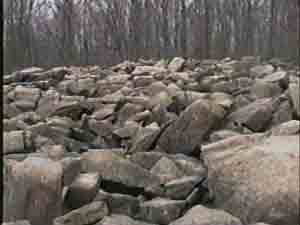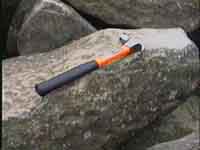pop up description layer
HOME
Cryptozoology UFO Mysteries Aviation Space & Time Dinosaurs Geology Archaeology Exploration 7 Wonders Surprising Science Troubled History Library Laboratory Attic Theater Store Index/Site Map Cyclorama
Search the Site: |
|
Weird Geology: Ringing Rocks
Not far from where General Washington made his famous crossing of the Delaware lies a strange place. Within a forest sits an open field, strewn with boulders and rocks of various shapes and sizes. The area seems devoid of any vegetation, save the lichens growing on the rocks. While such an area within the confines of Pennsylvania's forested Bucks County seems unusual in and of itself, it is a property of the rocks themselves that make the location so strange. They ring. Stones do not usually ring, but when these particular stones are struck lightly with a hammer, they will vibrate and make a sound not unlike that of a bell. Why they do this is still a mystery to science. The rocks themselves are composed of diabase, the same type of rock that makes up most the earth's crust. Another part of the mystery is while all the rocks seem to be made of the same material (mostly iron and hard minerals) only one-third of them generate the ringing sound when hit. Rocks that ring are known as "live" rocks, and those that don't are referred to as "dead" rocks.
In 1965 a geologist named Richard Faas from Lafayette College in nearby Easton, Pennsylvania, took a few of the rocks back to his lab for testing. He found that when the rocks were struck they created a series of tones at frequencies lower than the human ear can hear. Only because the tones interact with each other is a sound high pitched enough to be audible generated. Though Faas's experiments with the rocks explained the nature of the tones he was unable to figure out the specific physical mechanism in the rock that made them, though scientists suspect it has something to do with stress within the rocks. Some have asserted supernatural claims for the rocks and the field in which they are found. They note that little vegetation and animal life (including insects) inhabit the area. This is not surprising, though, as the boulder field, which is some ten feet thick and seven acres in size, is hotter than the surrounding forest and provides little food or shelter. Claims have been made that compasses don't work there, but attempts to see if the area has any unusual properties, beyond the rocks themselves, such as high background radiation, abnormal magnetic fields, or strange electromagnetic activity, have yielded nothing. People have known about the Bucks County site for some time. In June of 1890, Dr. J.J. Ott collected a number of the rocks which rang at different pitches, then with the assistance of a brass band, played a number of musical selections on the rocks for the Buckwampum Historical Society. Dr. Ott's performance qualifies perhaps as the first "rock concert" in history. More recently some local musicians have put together "jam" sessions on the rocks, striking them with various implements, including other rocks, sticks, hammers and railroad spikes. Some of these concerts have been featured on The Learning Channel's Strange Science series. The phenomenon of ringing rocks is not limited to Pennsylvania. They have been found all over the world. Interesting enough, though, ringing rocks at other locations are often composed of different materials. What physical characteristics they have in common with those in Pennsylvania that might explain the ringing is still unknown to geologists, however, so the mystery continues. Copyright Lee Krystek 2001. All Rights Reserved. |
|
Related Links |
|
|




